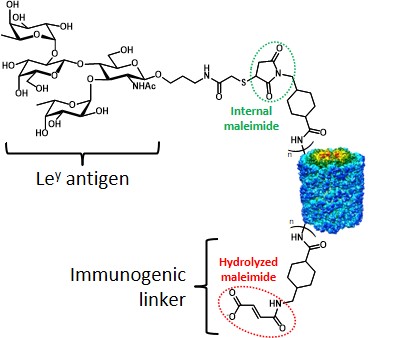Despite these important results obtained in the field of chemical immunology, the carrier-protein approach suffers from some limitations. The TACA-protein conjugation chemistry represents a first, problematic aspect of the semi-synthetic strategy. In early models, as seen for GD3-protein conjugates, the sugar moiety underwent ozonolysis at the ceramide portion to give an aldehyde group which allowed the conjugation to the amino groups in the KLH protein (Scheme 1).Helling et al., 1994Another classical and broadly employed method for oligosaccharide-protein conjugation involves the reductive amination between the open-chain aldehyde of the sugar reducing end and the amino groups of the protein. 105 The first alternative conjugation methods exploited modified carbohydrate containing linkers, such as maleimide, able to react more efficiently with thiol groups of protein’s Cys residues. 106 As illustrated over the various examples in this section, the TACA:protein conjugation ratio it is difficult to control, giving rise to batches with different TACA densities, and therefore leading to ambiguities in composition and structure. Moreover, due to the high molecular weight of carrier proteins (e.g. KLH = 8.6 x 106) the characterization of the semi-synthetic constructs remains challenging. Following the general rule that a higher loading of tumor-associated antigen is associated to a stronger immune response, it is clear how the conjugation control and the characterization of conjugate vaccines play central roles for ensuring efficient and reproducible immune responses.
The nature of the linker employed for the conjugation of the carbohydrate moiety to the carrier protein also represents an important aspect which has immunological consequences. Boons and co-workers found that the widely employed cyclohexyl maleimide linker was responsible for the reduced immune response towards a Ley-KLH conjugate vaccine in mice (Figure 7).Buskas, Li & Boons, 2004 It is widely known in literature that a maleimide function is susceptible to hydrolysis, even at slightly basic pH. Despite the stabilizing effect of the neighboring cyclohexane moiety, it has been demonstrated that hydrolysis occurs after only 2 hours at pH 7.0.Partis et al., 1983 The authors reported the production of anti-linker IgG and IgM antibodies and reasoned that this epitope-suppressing immune response was directed against the hydrolyzed maleimides and not against the “internal” ones, underlining that the extent of functionalized maleimides was about 80%.

Another major drawback associated to the utilization of a protein carrier concerns their inherent high immunogenicity, which can lead to the hapten-specific immune suppression, a phenomenon known as carrier-induced epitope suppression (CIES).(Dagan, Poolman & Siegrist, 2010Herzenberg, Tokuhisa & Herzenberg, 1980). Proteins like KLH, TTox and non-toxic bacterial toxin mutants contains several MHC-II epitopes ; in CIES, interference is thought to arise from competition between haptens (peptides or saccharides) bound to carrier proteins for a limited number of carrier-specific primed helper T cells. As a result, the antibody response to the carrier is increased, while the antibody production against the hapten is suppressed. This situation is exacerbated in case of repeated vaccination with the same carrier protein and has inspired researchers to find alternative carriers and approaches.
